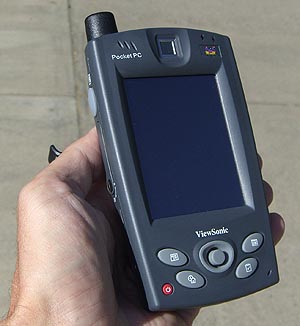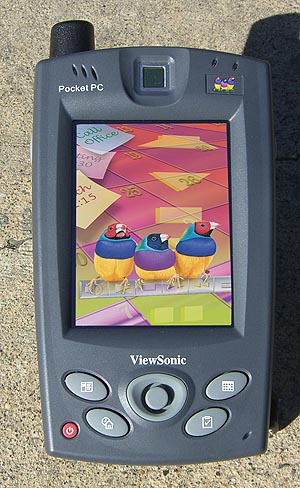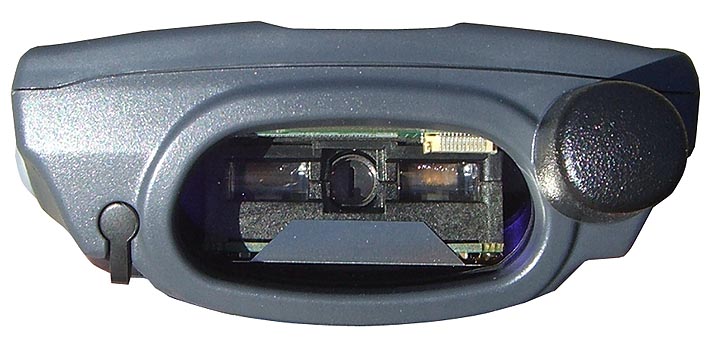|
ViewSonic V38r-02
Innovative, versatile and very rugged Enterprise Digital Assistant
(by Conrad H. Blickenstorfer)
ViewSonic has always been known to test the waters with all sorts of new technology.  If it doesn't work out they cut their losses and move on. ViewSonic was a pioneer in webpad technology, network computers and thin clients when those technologies seemed poised to make it big. If it doesn't work out they cut their losses and move on. ViewSonic was a pioneer in webpad technology, network computers and thin clients when those technologies seemed poised to make it big.
When the Microsoft-spec Tablet PC came along in late 2002, ViewSonic was there with a no-nonsense, very utilitarian Tablet PC slate that saw successful duty in a variety of vertical market applications. We reviewed a very attractive second Tablet PC product, the V1250 and found it an elegant, powerful machine that we wish were still in ViewSonic's lineup.
ViewSonic was also one of the very few companies that gamely participated in Microsoft's "Mira" Smart Display project that sought to use wireless tablets with limited local functionality and make them act as smart terminals to Windows XP hosts. Microsoft ditched that project, leaving ViewSonic stranded, but once again, the company earned major brownie points as an innovator never afraid to take a chance.
Later, ViewSonic offered a lineup of Pocket PCs. They did decent products with some innovation, but the timing of their introduction was poor as it pretty much coincided with a general downturn in PDAs in favor of smartphones and premium cellphones. But once again ViewSonic had shown that it never shies away from a challenge.
Back to the core, but the innovative spirit prevails
These days, ViewSonic is mostly concentrating on its roots and core business, that of providing large-size display products, be they desktop displays, large screen displays, digital TVs, projectors, or anything relating to them. But innovation in the mobile area is not dead at ViewSonic. A webpad is still available, now called the airsync V210 Wireless Tablet Client. It is a clever CE .NET-based slate that weighs less than three pounds and communicates with hosts via an 802.11b/g wireless network. There is definitely room in the world for such a product, and few others than ViewSonic offer them nowadays.
Getting into the lucrative rugged PDA market
More importantly, perhaps, ViewSonic noticed that there is one area where PDAs not only continue to exist, but where they are establishing
themselves as an increasingly lucrative market niche. That niche is ruggedized handhelds. Field force automation has been a holy grail of productivity enhancement for a large variety of industries for a good decade now. More and more companies are switching from paper-based systems or ancient proprietary terminal systems to modern wireless handhelds. The cost-benefit of these conversions is such that the likes of Symbol Technologies, Intermec, and other manufacturers of rugged mobile handhelds can barely keep up with demand.
The V38r platform
So ViewSonic is getting into this market with the V38r line of rugged mobile Pocket PCs. They call them "enterprise digital assistants" for use in industries where versatile, rugged mobility is a must. So they need to be able to survive the occasional drop as well as rough handling and a degree of exposure to the elements. In addition, they must be based on state-of-the-art technology (or as close as rugged devices generally get) and also pay attention to the industry's increasing emphasis on security and an ever-increasing slew of regulations.
The picture below shows a sideview of the V38r. As you can see, it is a
sturdy device very unlike commercial PDAs with their ultra-slender, gleaming
shells. This is a machine built for a purpose. Note the SD Card slot covered
by a sealed door. Or the large button that can be manipulated even with
gloves on. Or the antenna nub that makes for superior reception. The bulge
at the buttom is the cover of the extended life battery that provides
full-shift operation.

So what all of this means is that while you can no longer buy a new consumer ViewSonic Pocket PC, the company now offers a series of ruggedized handhelds based on the Windows Mobile Pocket PC platform. The ViewSonic V38r line of handhelds (there are four slightly different ones) are device that merge appropriate, advanced technology with the kind of ruggedness required for commercial and light industrial applications.
A description of the V38r
 But let me first describe the V38r platform and then the different models. What we have here is a ruggedized Pocket PC. I once got into hot water with a manufacturer when I insinuated that industrial Pocket PCs are simply consumer versions clad in hardened shells. I still feel that is true for some heavier-duty Pocket PC devices, but readily agree that it is not the case for all. The ViewSonic V38 platform is definitely not just a reinforced Pocket PC with extra padding. Instead, it is a meticulously designed and executed tool for mobile computing in harsh and demanding environments. But let me first describe the V38r platform and then the different models. What we have here is a ruggedized Pocket PC. I once got into hot water with a manufacturer when I insinuated that industrial Pocket PCs are simply consumer versions clad in hardened shells. I still feel that is true for some heavier-duty Pocket PC devices, but readily agree that it is not the case for all. The ViewSonic V38 platform is definitely not just a reinforced Pocket PC with extra padding. Instead, it is a meticulously designed and executed tool for mobile computing in harsh and demanding environments.
The V38 handhelds measure 5.75 x 3.375 times roughly 1.25 inches. I say "roughly" because the thickness depends on whether or not you use the optional extended battery or one of the various hand strap and belt clip attachments. The housing of the device is made of thick, industrial-looking gray plastic. Despite its relatively large size the unit fits perfectly into one's hand and ergonomics are first-rate. Fit and finish of the housing are exemplary. There are lots of lines and concave and convex surfaces, but everything
fits together perfectly, without any gaps, hard edges that could bite into your hand, or anything else that doesn't look quite right.
While the V38 is easy to hold in your hand, it is a "Pocket PC" only if your pocket is very large. So ViewSonic engineered a handy screw-on belt clip that securely attaches the device to a belt, but easily releases it with the firm push of a button. The belt-clip assembly also serves as the anchor point of a Velcro strap that attaches an equally well-engineered plastic screen cover that very tightly snaps onto the top of the device. Very clever. There's also a tether for the 4-inch plastic stylus for those who fear they might lose it.
The V38 uses the conventional Pocket PC button and control placement, i.e. it has a five-way navigation knob flanked by two function buttons below the display. All are large enough to easily be operated even with gloves on. A button on the left activate the voice recorder, one on the right the integrated bar ode reader. The only other button is a small red on/off switch on the bottom left.
Under the hood
As far as specifications go, the V38s all use 416 MHz versions of the Intel XScale PXA 270 processor, have 64MB of Flash and either 64 or 128MB of SDRAM. There is a SD Card slot that sits under an O-ring sealed door. The display is a transflective 3.5-inch diagonal affair that supports 256k colors. The digitizer uses a 4-wire design and sports a 3H hardness (yes, that is the same hardness scale used for lead pencils).
For charging and connectivity, the V38 uses a proprietary connector that uses either an AC power dongle or a special communications/power dongle that has port a USB 1.1 port and a standard 9-pin serial connector. There is no separate power jack, so make sure you don't lose the power or USB/serial adapter. USB, by the way, is both host and client.
These days, no device is an island, and so the V38r comes with integrated 802.11b/g wireless with support for WEP 64/128, as well as more secure wireless protocols such as WPA RADIUS, WPA-PSK and a variety of Microsoft variants. There is also an IR port.
Access security is provided via an integrated 128x128 fingerprint authentication sensor located above the device.
Scanning and imaging
The V38r comes with a 1-D CCD image engine that supports a variety of bar code format: UPC, EAN, Code 39, Code 128, UCC, EAN 128, ISBN, Interleaved, Matrix, Industrial and Standard 2 of 5, Codabar, Code 93, MSI, Plessey and Telepen. The scanner is triggered by the right-side button.

Some models also have a 1.3 megapixel CMOS digital camera that creates remarkably good pictures. And even has fairly bright LED illumination for low-light conditions. The VSCam software is easy to use and quite configurable with seven brightness settings, six white balance settings, a self-timer, continuous shooting of up to six pictures, and more.
Power
For power, you have your choice of a standard 3.7V/1,800mAH or an extended 3,7V/3,600mAH battery. Both are field-replaceable and sit under an O-ring sealed cover that is secured with a twist wheel. The standard battery lasts about four hours, the extended one, which adds a 3/8th-inch "power bulge", up to eight. We'll take the latter any day.
Environmental specs
Moving on to environmental specifications, they are impressive. The device is sealed to IP54 standards, which mean the device is protected against dust and against water spray from all directions. It can survive multiple 4-foot drops, and operate at temperatures between -10 and 55 degrees Celsius, which converts into14 to 130 degree Fahrenheit. That's quite impressive.
Different models
The V38r comes in several configurations. The 01/02 model differ in that the 02 has twice the amount of SDRAM (128MB instead of 64), the fingerprint scanner, a microphone with echo cancellation for Voice over IP applications, and the extended battery. With all that, it weighs 14 ounces as opposed to the 01's 12 ounces. There is also a special 02A version for government applications. Finally, there's the 05 model that comes fully equipped, but with Windows CE .NET 4.2 as opposed to Windows Mobile for Pocket PC 2003. So as you can see, the differences are not great. As far as pricing goes, the basic V38r-01 retails for US$1,499, the V38r-02 and the CE .NET-based model 05 for US$1,799, and the government version for US$1,899.
An attractive proposition
Overall, the V38r line of rugged "Enterprise Digital Assistants" offers a lot. It is an extremely well made, very rugged device with modern features and technology. It comes in different models for different applications. The integrated CCD Imager and the separate 1.3 megapixel digital camera add great functionality. The availability of a CE .NET version extends the device's reach into applications and industries where custom programming is a necessity. Pricing is reasonable, and in ViewSonic customers will deal with a company with a long, proven track record of both stability and innovation. About the only thing we're missing is an upgrade to the latest versions of Microsoft's OS platform, those being the Windows CE 5.0 versions of the PPC and CE .NET variants. -- Conrad H. Blickenstorfer
www.viewsonic.com
| Type |
Rugged Pocket PC "Enterprise Digital Assistant"
|
| Processor |
416MHz Intel PXA270 |
| OS |
Windows Mobile Pocket PC 2003 or CE .NET 4.2 |
| Memory |
64MB Flash and 64-128MB SDRAM |
| Display |
3.5" transflective TFT |
| Digitizer/Pens |
Touchscreen |
| Keyboard |
onscreen |
| Expansion |
Sealed SD Card |
| Size |
5.75" x 3.375" x 1.25" |
| Ruggedness |
IP54, 4-foot drop |
| Weight |
14-16 ounces incl. battery pack |
| Power |
Replaceable 1,800 or 3,600mAh 3.7V Li-Ion ("4 or 8 hours") |
| Communication |
Internal 802.11b/g wireless LAN, IR |
| Interface |
USB host/client, audio/mic, serial, 1-D CCD Image Engine, 1.3 megapixel digital camera, dock |
| Price |
starting at US$1,499 |
| Contact |
Viewsonic |
|



